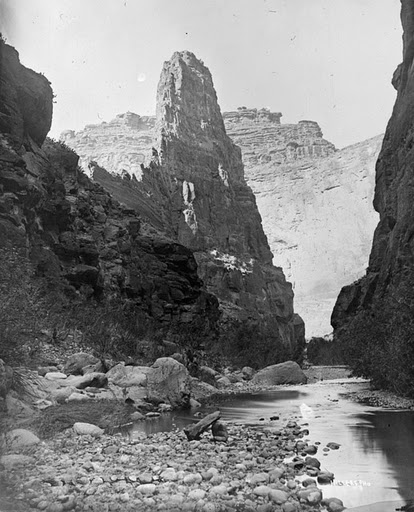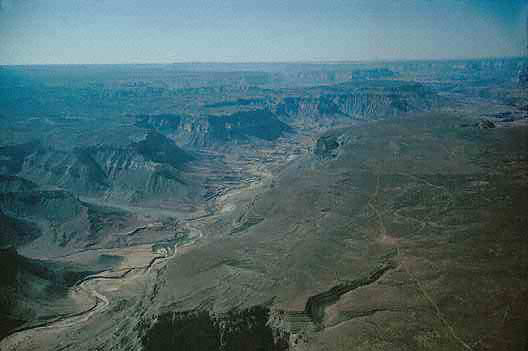Kanab Creek begins as one of many washes coming out of the Vermilion Cliffs on the Arizona Strip. As with many tributaries and side canyons at the Grand Canyon, the creek has carved a canyon that is majestic in its own right as it flows south 50 miles to the Colorado River, yet it is overshadowed by the monstrous chasm that it drains into. In fact, Kanab Creek is the largest tributary canyon system on the north side of the Grand Canyon. The creek is one of the rare streams that actually pre-dates, or at least coincided with, the Colorado River’s first cutting of the Canyon.
Kanab is a Paiute word for willow, trees which can be found throughout the canyon formed by the creek. Many of the earliest Euro American visitors to the Grand Canyon came to the North Rim, and many would stop near this creek for water. Mormons came to the area in the 1860s, settling Kanab, Utah, along the creek in 1870 and its sister city Fredonia, Arizona, downstream in 1882. However, the creek’s water flow was intermittent, which made it unsuitable for large-scale irrigation farming.

In 1871-72 John Wesley Powell led a second expedition to the Grand Canyon area, this time armed with surveyors and photographers, who took pictures such as this. These surveyors found a small amount of gold in the creek, causing a minor gold rush to the area.
Credit: NAU Cline Library, John K. Hillers Collection, NAU.PH.1999.80.71
In 1871, members of John Wesley Powell’s survey team found gold in the Colorado River at its junction with Kanab Creek. For the next several months, hundreds of men flooded into and back out of the area, traveling down Kanab Creek and panning for gold. When little came of these efforts, would-be prospectors quickly moved on to other mining areas.
Eventually some copper mines were established in the area, but these were not highly productive. However, after WWII and the advent of the atomic age, uranium became increasingly valuable. Prospectors investigating old copper mines found that the Kaibab Plateau held some of the richest uranium-containing ore they had seen. Several uranium mines were opened along Kanab Creek.
Part of the area around the creek in Arizona was designated as the Kanab Creek Wilderness Area in 1984 and is administered by the U.S. Forest Service and Bureau of Land Management. While on the canyon rims the land is arid with sparse desert vegetation, but in the creek bottom a rich riparian community is home to a variety of plants and animals. Kaibab mule deer find forage above, while desert bighorn sheep and peregrine falcons makee their homes within its walls. Though hiking trails are available in the area, they are minimally maintained, and because of extreme heat and lack of water summer hiking is not recommended.
Written By Sarah Bohl Gerke
Suggested Reading:
- Anderson, Michael F. Living at the Edge: Explorers, Exploiters and Settlers of the Grand Canyon Region. Grand Canyon Association, 1998.
- Ghiglieri, Michael P. Canyon. Tucson: University of Arizona Press, 1992.

